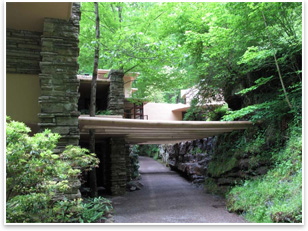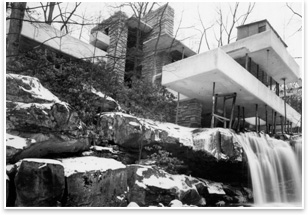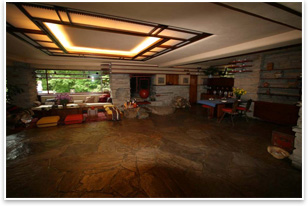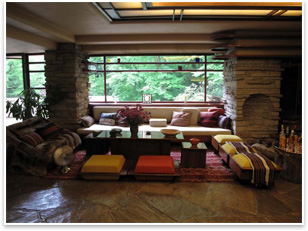Fallingwater Part 4
The Story of a Country House—Construction
by Jim Atkins, FAIA
“In this design for living down in a glen in a deep forest, shelter took on definite masonry form…”
—Frank Lloyd Wright, 1938

The entrance to Fallingwater. Photo by Dr. Sook Kim, courtesy of the Western Pennsylvania Conservancy. The last installment of this series traced the slow development of Fallingwater’s design—almost nine months passed after Wright received the commission before he reportedly picked up a pencil to start the design work. And when he did finally begin, the story goes that it was only two hours before his client Edgar Kaufmann was to arrive from Milwaukee to view his progress. This legendary tale has Wright meeting Kaufmann at the door, ready to present the completed drawings and discuss the details of the design, only minutes after he completed them.
Kaufmann was surprised to find that Wright had located the house on top of the waterfall instead of at a vantage point below it where the falls could be viewed. However, he acquiesced to Wright’s explanation and accepted his design.
Kaufmann went immediately back to Bear Run and began preparations for construction. However, it would be much more time before Wright completed the first set of construction drawings, and this interlude would prove to be only one of many as the construction phase moved glacially toward completion.
A rocky start
The construction phase of Fallingwater was wrought with so many obstacles and challenges that it is quite remarkable that the project was as successful as it turned out to be. Management changes, schedule delays, design problems, and poor workmanship plagued the project incessantly. Even the great icons of the profession are not immune to the challenges of the profession.
Taliesin apprentice Bob Mosher was on site to observe construction and provide design clarifications and details. He replaced the earlier appointed Abe Dombar, who was also working as assistant art director for Kaufmann at his big store in downtown Pittsburgh.
The Morris Knowles engineers laid out the building foundation on April 16, 1936, and later they laid out the new concrete bridge leading to the house. Wright instructed Mosher to use the large boulder by the falls as the datum point for locating the floor elevations of the house.
Mosher was called upon to make changes in Wright’s design to accommodate variations in the site, adding a plunge pool by the stream allegedly as a result of an error in the Knowles’ drawings locating the streambed four feet higher than it actually was. Mosher did a commendable job of working with the large group of stonemasons with no experienced contractor in charge.
Who’s in charge?
Although Norbert Zeller was initially retained in late 1935 as the contractor, his tenure was cut short by his stint in the local jail. In May he was summarily discharged by Edgar, who continued personally to manage a crew at the quarry. Most of 1936 would pass before a professional contractor was finally retained.
Before that happened, as a temporary measure, Kaufmann appointed his store’s assistant general manager, Carl Thumm, to manage the construction operations. Wright was quite annoyed by the addition of this “middleman” and complained persistently to Kaufmann about the “Thumm in the soup.”
By the end of June, Mosher had coordinated the installation of the stone bases, and the three concrete “bolsters,” or beams supporting the building, had been put in place. Then, only days later, a new bolster design arrived from Taliesin. The new design had the bolsters in a more streamlined V shape. Mosher had the first ones torn out and the new design in place by the end of July.

Forming the great-room slab over the bolsters. Photo courtesy of the Western Pennsylvania Conservancy.
Wright and Mosher were not effectively communicating. They clashed on dimensional as well as design concepts. Such communications were very slow and limited compared to today’s technology with Blackberries, cell phones, and our ability to exchange digital files. Wright finally told Kaufmann that he would no longer send out structural information until a qualified contractor was brought on board. That man selected was Walter J. Hall.
Walter J. Hall
Walter J. Hall was about the same age as Wright with 40 years’ experience building houses around Port Allegany in north-central Pennsylvania. Hall was a great admirer of Wright, and many of his houses were built in Wright’s style. He made his deal with Kaufmann and signed on for work on July 13, 1936.
The success of all projects depends heavily on the use of a qualified contractor; Fallingwater was no exception. The connection between Wright and Hall that led to his hiring followed multiple paths.
Hall’s son, Raymond, contacted Wright in 1934 to find out how he could join the Taliesin Fellowship. He did not have the money, but in his letter he mentioned his father’s skills at construction. It could have been the letter that caused Wright to send his son John to Port Allegany in 1935 to check out Hall.
John Wright took a look at Lynn Hall, the hotel Hall was in the process of building. The design similarities to Wright’s work were apparently obvious, and a large, clear span concrete beam across the hotel lounge was probably no less eye-catching. John gave positive reports on Hall to his dad.
A third path of contact came through a former employee of Hall’s, Earl Friar, who at the time tended to Wright’s farm buildings. Friar had kept in contact with his former boss. From a marketing standpoint, Hall could not have been more fortunate or better represented.
Hall had the somewhat rare distinction of having experience with reinforced concrete designs, which was essential in the construction of Fallingwater. He was also skilled at masonry construction, and he was intimately involved with the creation of the attractive stone-tapestry walls. He is responsible for the rich textured appearance that emulates the sandstone formations in the Bear Run area.
Frank Lloyd Wright and Portland Cement
Portland cement is credited to an English bricklayer named Joseph Aspdin who filed his patent in 1824. He called his invention “Portland cement” after the building stone quarried in the Isle of Portland. European companies began importing Portland cement to the United States by the 1880s. Wright’s first use of Portland cement was with Unity Temple in Chicago, completed in 1908. He considered the material “cheap” yet capable of being made as dignified as traditional masonry. Wright went on to use many unique forms of concrete in his work, including his Usonian concrete blocks and the concrete front door on the Hollyhock house. His most dramatic use of the material is in the Solomon R. Guggenheim Museum in New York. Wright relished the fluid power of concrete, claiming that the Guggenheim would make the nearby Metropolitan Museum of Art “look like a Protestant barn.”
The cantilevers
The design of the Fallingwater cantilevers was provided by Mendel Glickman. He had emigrated from Russia where he worked as chief engineer for an American firm building a tractor plant in Russia. He had contacted Wright, and Wright was impressed with him to the extent that he hired him to engineer the infamous “lily pad” columns at the Johnson Wax Building in Racine. Wright’s respect was apparently far reaching, for many years later Wright allowed Glickman and his wife burial at the ancestral Lloyd Jones cemetery in Spring Green.
Assisting Glickman was Wright’s son-in-law, Wes Peters, who had training in engineering, but did not have a lot of experience. He served as an assistant and back-up to Glickman. By the end of June they were working on the reinforcing design for the bolsters and the steel reinforcing detailing for the first supported concrete floor.
The technical configuration of the cantilevered slabs at Fallingwater is an upside down version of how such designs are commonly used. Instead of protruding vertical beams with the slab on top, at Fallingwater the slab is on the bottom with the beams on top, forming I shapes above the slab. Wood sleepers were attached to the tops of the beams, or I’s, and a plywood subfloor spans the sleepers covered by asphalt roof sheathing and a bed of sand. The flagstone floor is placed over the sand bed.
Wright’s design provides for a smooth surface underneath the cantilever, avoiding the exposed “ribs” of the beams, perhaps to acknowledge the clean lines of the International Style. It also provides an enclosed cavity under the finished floor for sound attenuation of the rushing waters below and to conceal building mechanical components.
Concrete beams supporting a cantilever must be reinforced with steel rods because concrete has a very low tensile strength, and the weight of the slab bending the beams downward while supported only at one end causes significant tensional forces in the top side of the beams and slab, much like stretching a rubber band.
Since virtually all concrete designs at the time were simple spans where the beam was supported at both ends and was in compression at the top and tension at the bottom, the amount of reinforcing steel was much less, and the behavior of the beam was more easily understood.
Wright had limited studies in engineering during his two semesters at the University of Wisconsin in Madison, and he was likely out of his element on the matter. Combined with the complex nature of the design, it is not surprising that the design was insufficient.

Construction from southwest—temporary shoring supporting the cantilevers. Walter J. Hall’s construction shack sits atop Liliane’s terrace. Photo courtesy of the Western Pennsylvania Conservancy.
A second opinion
Kaufmann was a practical man who left little to chance, and he was also trained as an engineer. Accordingly, he hired his own engineering firm, the Metzger-Richardson Company, to check the Glickman structural design. Metzger-Richardson was a Pittsburgh firm that specialized in designing concrete structures.
Wright’s revised design called for eight three-quarter-inch-square steel bars in each beam. Metzger-Richardson maintained that sixteen one-inch square bars were needed. This is over two and one-half times the steel in the Glickman-Peters design, and four times Wright’s original design using half-inch bars. Remember that the beam is primarily in tension, and the cross section of the steel is what is required to keep it from failing.
Kaufman directed the contractor to install the additional steel, and Wright’s man on the site, Mosher, gave in, but he did not immediately inform Wright. The contractor, Hall, was caught between following Wright’s design and Kaufmann’s directive, and he surreptitiously added steel according to Mosher. He apparently added additional one inch square bars to the smaller bars already in the formwork, thus adding more steel than Wright specified, but less than Metzger-Richardson had called for.
The concrete was placed on August 19. Moser finally wrote to Wright on August 25. He complained about the contractor’s skill and the work technique and quality, and he finished the letter by noting that he was enclosing calculations made by Kaufmann’s engineers who contended that more steel was necessary in the beams, which were put in at the last moment.
Wright’s reaction was less than benign, to say the least. He considered Kaufmann’s review of his work “an insult,” and sparks flew wildly. But somehow construction continued, and Hall proved to be the man for the job.

The great room with the protruding stone hearth. Photo by Jim Atkins, courtesy of the Western Pennsylvania Conservancy.
The interior
Wright’s design for Fallingwater was a complete work and included the interior furnishings. Today, the house contains 169 pieces of custom furniture, both built-in and moveable. It is a treasure beyond any other Wright house. Historian Franklin Toker describes it as, “… one of the most complete designed settings anywhere for the use of a 20th-century family.”
The furniture was made of North Carolina black walnut and produced by the Gillen Woodworking Corporation in Milwaukee. The company was an offshoot of Matthews Bros. Manufacturing Company, which had fallen victim to the Great Depression and was sold at auction. George Gillen, a former VP at Matthews, formed the new company with many of the same artisans.
Wright imposed his design preferences on Kaufmann, as Donald Hoffmann cites in his book, Frank Lloyd Wright’s Fallingwater. “E.J. thinks that walnut [is] too dark,” Mosher reported on March 27, “but I said that a lighter wood would make everything too neutral in color.”
The Kaufmann’s strived to stay on the leading edge of technology, including a “sound recorder” located in the deep case at the seat near the entry. Later, the kitchen would include one of the first automatic dishwashers. Edgar Kaufmann jr. proposed that the unique ottoman seat cushions be made of “Dunlopillo,” an early foam rubber developed by the Dunlop Tire & Rubber Company of Buffalo.
Dunlopillo
In 1929, a research scientist working in the Dunlop Tire & Rubber Company lab accidentally discovered that mixing together and heating soap, liquid latex, and gelling agents would create latex foam. Its use immediately became widespread for theater seating, cushions for cars and airplanes, and of course pillows and mattresses. The huge British industrial company, BTR, acquired Dunlop in 1985, and they distribute today’s version of Fallingwater’s cushions in the form of Dunlopillo UK Talalay Latex, which boasts: “Dunlopillo’s latex cushions lasted over 60 years in Fallingwater…”
Wright and Kaufmann clashed over the cost of the millwork, and at one point when Edgar thought the millwork costs to be too high and demanded he be sent the drawings, Wright responded: “No client has a right to give orders over his architect’s head.”

Seating near the hearth in the great room—note the Dunlopillo seat cushions. Photo by Dr. Sook Kim, courtesy of the Western Pennsylvania Conservancy.
Wright obviously took liberties back then that most of us today would be reluctant to do, especially those of us who work for developers. Nonetheless, Kaufmann remained deeply involved in the construction process, and he exerted himself at will.
The costs spiraled to $70,000, more than double the original estimate. Meanwhile, Wright pressed Kaufmann for more fees. Kaufmann did not answer Wright’s plea and took issue with the quality of Gillen’s millwork. Wright, having chosen the company, sprang to their defense.
Completion
Such was the relationship between Wright and Kaufmann, both men exercising an assertiveness that never ceased. Yet good ideas came from both of them, and their kinetic and often conflicting relationship proved to be a winning combination.
Hall would ultimately complete Fallingwater, and the Kaufmanns took occupancy in November 1937 in time for Thanksgiving. It had been three years since Wright and Kaufmann had first walked the site to discuss the new country house.
Hall’s contributions to Fallingwater were many. He admired and emulated Wright’s designs in his work, and he was experienced in cast-in-place reinforced concrete. But perhaps his most visible gift to Fallingwater was the masonry work; the rich stone tapestry that blended the Modern residence with the hill around it.

The stone tapestry of Fallingwater. Photo by Dr. Sook Kim, courtesy of the Western Pennsylvania Conservancy.
Fallingwater is the rock from which it was born, and it is the cool, flowing water that it delicately embraces. It is truly a physical expression of Wright’s most fervent desire, to have the house and its surroundings be as one.
It is a thing of beauty, a piece of livable art, and one wonders how it could possibly have a flaw or blemish. Yet it does. The flaws of Fallingwater were not immediately apparent to the observer. They did not visually corrupt its beauty and magnificence. The troubles within this icon lay beneath its richly crafted surfaces; a time bomb destined to destroy the master’s creation, unless it could be stopped.
Next installment
Wright was celebrated as a major force in Modern design, but his innovative creation was not without its faults. The house contained defects and inadequacies that could ultimately fail catastrophically and send it into the stream bed below.
The next installment examines the imperfections of Fallingwater. As innovative and successful as it was, its structure was on a progressive journey toward failure. We will look at the causes of the failed design along with the impressive and innovative repairs undertaken in 2002. Don’t miss the next adventure in architecture, and good luck out there. |







